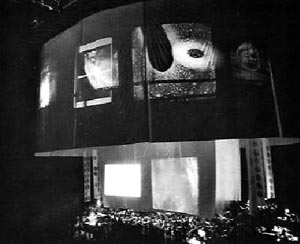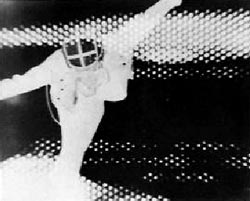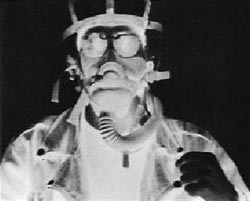[ index | VIDEO | 1968 ]
John Cage and Ronald Nameth: HPSCHD
Computer-composed and computer-generated music programmed by John Cage and Lejaren Hiller during 1967-69 was premiered in a spectacular five-hour intermedia event called HPSCHD (computer abbreviation for Harpsichord) at the University of Illinois in May, 1969. Computer-written music consisted of twenty-minute solos for one to seven amplified harpsichords, based on Mozart's whimsical Dice Game music (K. Anh. C 30.01), one of the earliest examples of the chance operations that inform Cage's work. Computer-generated tapes were played through a system of one to fifty-two loudspeakers, each with its own tape deck and amplifier, in a circle surrounding the audience. Cage stipulated that the compositions were to be used "in whole or in part, in any combination with or without interruptions, to make an indeterminate concert of any agreed-upon length."

The university's 16,000-seat Assembly Hall in which the event was staged is an architectural analogue of the planetary system: concentric circular promenades and long radial aisles stretching from the central arena to the eaves of the domed ceiling. Each of the forty-eight huge windows, which surround the outside of the building, was covered with opaque polyethylene upon which slides and films were projected: thus people blocks away could see the entire structure glowing and pulsating like some mammoth magic lantern.
Over the central arena hung eleven opaque polyethylene screens, each one hundred feet wide and spaced about two feet apart. Enclosing this was a ring of screens hanging one hundred and twentyfive feet down from the catwalk near the zenith of the dome. Film-maker and intermedia artist Ronald Nameth programmed more than eight thousand slides and one hundred films to be projected simultaneously on these surfaces in a theme following the history of man's awareness of the cosmos. "The visual material explored the macrocosm of space," Nameth explained, "while the music delved deep into the microcosmic world of the computer and its minute tonal separations. We began the succession of images with prehistoric cave drawings, man's earliest ideas of the universe, and proceeded through ancient astronomy to the present, including NASA movies of space walks. All the images were concerned with qualities of space, such as Méliès' Trip to the Moon and the computer films of the Whitney family. The people who participated in HPSCHD filled in the space between sound and image."
Seven amplified harpsichords flanked by old-fashioned floor lamps stood on draped platforms on the floor of the central arena beneath the galaxy of polyethylene and light. In addition to playing his own solo, each harpsichordist was free to play any of the others. Each tape composition, played through loudspeakers circling the hall in the last row of seats near the ceiling, used a different division of the octave, producing scales of from five to fifty-six steps. Only twice during the five-hour performance were all channels operating simultaneously; these intervals were stipulated by Cage.
Nameth has collaborated in several intermedia performances in addition to making his own computer films and videographic films, as well as conventional cinema such as Andy Warhol's Exploding Plastic Inevitable. In 1967 he worked with Cage in the preparation of Musicircus, an eight-hour marathon of sight and sound involving nearly three thousand persons - musicians, musical groups, orchestras, and composers in addition to a participating "audience" - all making music together.
In 1968-69 Nameth worked with Salvatore Martirano and Michael Holloway in a music/theatre/film presentation titled L.'s G.A. (Lincoln's Gettysburg Address), which traveled throughout the United States and Japan. Described as a mixed-media event "for gasmasked politico, helium bomb, three 16mm. movie projectors, and two-channel tape," L.'s G.A. was simultaneously a showcase for Martirano's electronic tape compositions, Nameth's multiple-projection cinema, and Holloway's poetry. Nameth employed video imagery for his cinematic triptych As the World Turns, which he described as "the visual counterpart of Martirano's music." Depending on the physical limitations of the performance space, Nameth's film was projected in the form of two smaller images side by side within a larger image, all three images adjacent to one another, or all three superimposed over one another.


Two scenes from Ronald Nameth's triple-projection film As the World Turns
for intermedia presentation L.'s G.A. 1968-69.
-- Gene Youngblood: EXPANDED CINEMA, 1970, [PDF /4.6 Mb]
[ index | 1968 ]